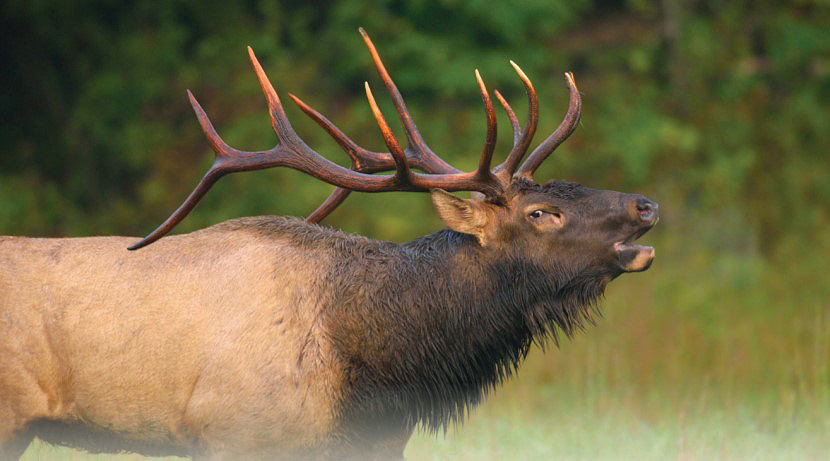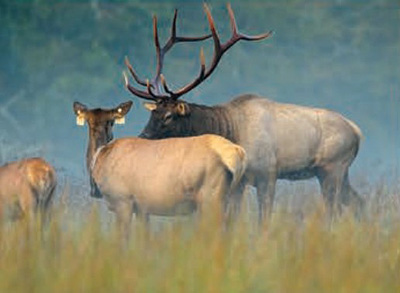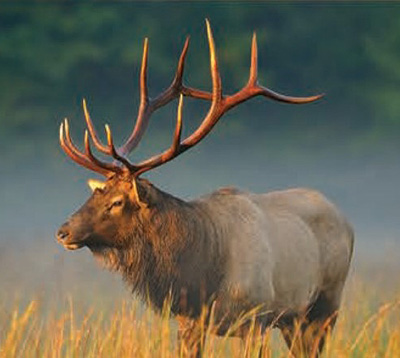Tes Jolly | Originally published in GameKeepers: Farming for Wildlife Magazine. To subscribe, click here.

The majestic elk is one of North America’s most iconic game animals, best known for the bull’s bugle call, a hair-raising primal roar, high-pitched whistle and grunt that carries for more than a mile. An estimated 10 million elk inhabited nearly all of the United States and Canada prior to European settlement. Elk are also called “wapiti.” The name is derived from the Shawnee Indian word “waapiti,” meaning “white rump.”
The North American elk, (Cervus elaphus), are divided into six subspecies. The Rocky Mountain elk of the Rocky Mountain West has the largest antlers of all the subspecies. The Roosevelt ranges the Coastal Pacific Northwest and is the largest in body size. The Tule in Central California is the smallest. The Manitoban lives in the northern Great Plains. The Merriams of the Southwest and Mexico and the Eastern elk lived east of the Mississippi River and are both extinct.
One of the largest in the deer family, a mature male bull elk stands 5 feet at the shoulder and averages 700 pounds. Tule elk weigh less and the Roosevelts can reach 900 pounds. Elk are very adaptable and live in areas from alpine meadows to rainforests and hardwood forests to desert valleys. Typically, elk habitat is a blend of large open areas and woodland cover.
 As opportunistic feeders, an elk’s diet consists of a wide variety of regional seasonal native grasses, shrubs, sedges, woody plants, buds, twigs and forbs. Elk migrate in response to severe weather conditions during winter and to avoid human pressure, particularly during calving season. In states where weather conditions do not trigger migration, summer and winter ranges may differ only slightly if cover and food requirements are available.
As opportunistic feeders, an elk’s diet consists of a wide variety of regional seasonal native grasses, shrubs, sedges, woody plants, buds, twigs and forbs. Elk migrate in response to severe weather conditions during winter and to avoid human pressure, particularly during calving season. In states where weather conditions do not trigger migration, summer and winter ranges may differ only slightly if cover and food requirements are available.
Elk are extremely vocal. They communicate and identify one another through squeals, barks, chirps, mews and bugling. The rut is a noisy, action-packed affair as bulls gather cows in harems, bugling to convey their status and fitness. Bugling also warns other bulls to stay away and proclaims a bull’s readiness to battle. Bulls urinate in muddy depressions and then wallow in the pungent concoction to attract cows and unnerve other bulls. Violent battles may end in injury or even death. Calves are dropped from late May to early June. Except during the rut, cows, calves and yearlings form herds and live apart from bulls that live alone or in bachelor groups.
As European expansion westward unfolded, elk were a plentiful resource for explorers, trappers and settlers. However, unregulated hunting, loss of habitat, grazing competition from domestic livestock, and urbanization throughout the 19th century decimated elk populations. Elk east of the Mississippi River disappeared by the late 1800s. By the early 1900s, less than 100,000 elk remained in North America.
In recent years, restoration programs have achieved success through the efforts of state wildlife agencies, universities, conservation groups including The Rocky Mountain Elk Foundation, conservation-minded hunters and concerned citizens. Elk are being successfully reintroduced to wilderness areas in their historical ranges, particularly in several states east of the Mississippi River. Today, an estimated one million elk live in the western United States, Wisconsin, Michigan, Minnesota, Missouri, Pennsylvania, Arkansas, Kentucky, Tennessee, West Virginia, Virginia, and North Carolina, and seven Canadian provinces.
Did you know…
- The antlers of a mature bull elk may weigh as much as 40 pounds.
- An elk’s top two canine teeth are called “ivories” and are believed to be remnants of saber-like tusks used by prehistoric elk in combat.
- A mature bull elk can run up to 40 miles per hour and is capable of an eight foot vertical jump.
- Researchers found that an elk’s ankle bones make a distinct popping or cracking noise when they walk. They surmise the sound may help alert other elk that they are being approached from behind.
- Scientific research shows a bull’s bugle has two components that involve independent sound sources in the elk’s body, a phenomenon called biphonation. A low-pitched roar originates from the vocal folds and a high pitched whistle is produced either by flaring and contracting the nostrils or by air vibrating the soft palate.
Elk Restoration East of the “Big Muddy”
 In 1990, the Rocky Mountain Elk Foundation partnered with multiple state agencies and universities and began funding feasibility studies to answer three important questions regarding restoration of wild, free-ranging elk into their former eastern habits. Can the habitat support elk? How will restoring elk affect the local economy and hunting? Will the local citizens accept the restored elk herd? Today, 8 states east of the Mississippi river have restored free-ranging elk herds.
In 1990, the Rocky Mountain Elk Foundation partnered with multiple state agencies and universities and began funding feasibility studies to answer three important questions regarding restoration of wild, free-ranging elk into their former eastern habits. Can the habitat support elk? How will restoring elk affect the local economy and hunting? Will the local citizens accept the restored elk herd? Today, 8 states east of the Mississippi river have restored free-ranging elk herds.
Pennsylvania: Population is about 1000 elk. The 2019 draw is142 tags.
Michigan: The management goal is 500-900 elk. Hunting has been offered since 1984.
Wisconsin: The state’s first managed elk hunt in the Clam Lake Elk Range was held in 2018.
Kentucky: Over 1,500 elk were released into eastern Kentucky’s Cumberland Plateau (estimated 4.1 million acres). The population estimate is over 13,000 elk. The 2019 quota hunt will issue 594 tags.
Tennessee: Population estimate is 350 elk. Yearly, 15 tags are drawn.
North Carolina: Currently no hunting is allowed for elk that disperse outside the Great Smoky Mountain National Park.
Virginia: Outside the restoration zone, elk are legal during any open deer season with proper license and permits.
West Virginia: Between 2016 and 2018 ninety elk were released into the southern coalfield area.The draft elk management plan defines an approach for a future hunting season.
Mossy Oak is a longtime supporter of the Rocky Mountain Elk Foundation and has helped the RMEF raise critical dollars for elk and elk country. Mossy Oak earned the Level V Gold Medallion Award in RMEF’s Partners In Conservation program.































